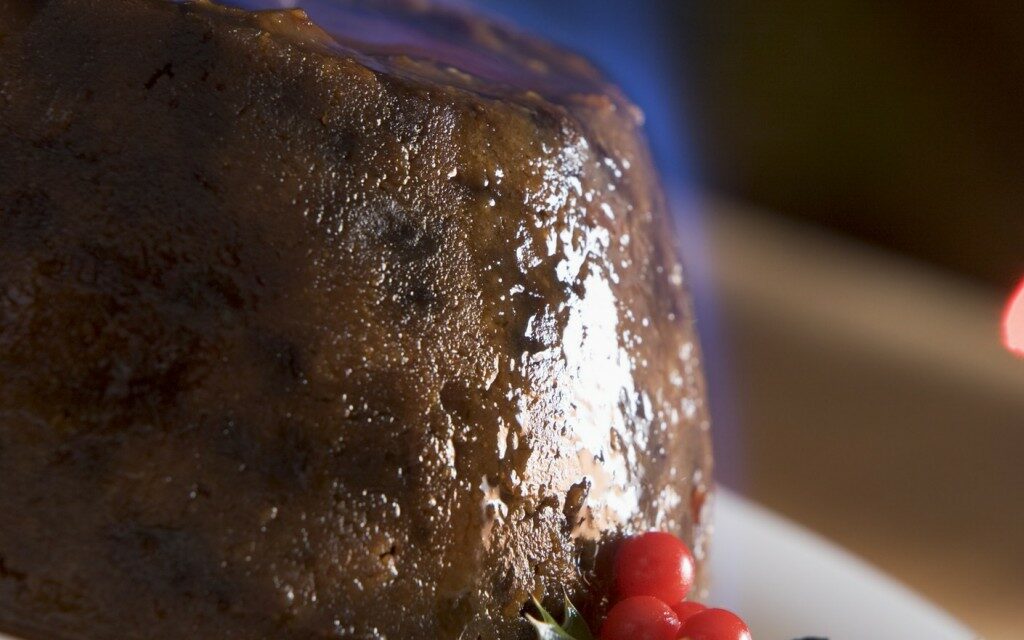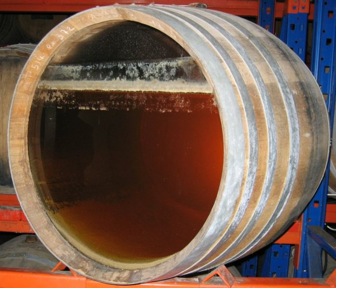By Jamie Drummond (with invaluable assistance from Nigel Slater and Charles Dickens)
“Mrs Cratchit left the room alone — too nervous to bear witnesses — to take the pudding up and bring it in…
Hallo! A great deal of steam! the pudding was out of the copper [boiler]. A smell like washing –day! That was the cloth [the pudding bag]. A smell like an eating house and a pastrycook’s next door to each other, with a laundress’s next door to that! That was the pudding! In half a minute Mrs. Cratchit entered—flushed, but smiling proudly—with the pudding. like a speckled cannon ball, so hard and firm, blazing in half of half-a-quartern of ignited brandy, and bedight with Christmas holly stuck into the top.”
“Oh, a wonderful pudding! Bob Cratchit said, and calmly too, that he regarded it as the greatest success achieved by Mrs. Cratchit since their marriage…”
Charles Dickens – A Christmas Carol (1843)
Sultanas – 350g
Currants – 350g
Dried Figs – 150g, chopped, hard stalks removed
Candied Peel – 125g, chopped
Dried Apricots – 100g, chopped
Dark Glacé Cherries – 75g, halved
Good quality brandy that has been sitting unused for the best part of 10 years – 150ml and then some
Quinces – 2, grated (In a pinch use apples)
Oranges – 2, zest and juice
Eggs – 6, beaten
Shredded Suet – 250g
Soft Brown Sugar – 350g
Fresh Breadcrumbs – 250g
Self-Raising Flour – 175g Spices: Nutmeg, Cinnamon, Ground Cloves, Ground Allspice, Ground Ginger
Löwenbrau Beer – 6 Cans
Perseverance – 750g
1- 6 months before Christmas find that you harbour some rather fond nostalgic memories of Christmas past, with particular focus around the traditional Christmas pudding. Somewhere deep within your dusty neural network discover that a passion to make that particular icon of the Victorian holiday celebrations is slowly emerging. Be sure to disregard any thoughts that this may possibly be a flight of culinary whimsy.
2- Some 5 months after feel a fervent grin of strangely erotic anticipation crossing your face as you flick through UK writer Nigel Slater’s Kitchen Diaries and stumble upon his take on the traditional Christmas pudding. Decide that THIS will be the year that you make Christmas pudding much to the delight of all your thankful friends and family. Swell with excitement as you realise that the recipe in question asks for enough ingredients to make not one, but TWO puddings!: one for Christmas day for your girlfriend’s French family up in Kapuskasing, Northern Ontario, and one to surprise your best friends with at a planned New Year’s Eve dinner party.

Stir-Up Sunday
3- Be sure to do some research upon the history of the Christmas pudding, discovering that the dishes’ origins can be traced back to the 1420’s, not as a dessert or confection but as a method of preserving meat with the aid of dried fruits at the end of the season. Marvel as you read that this traditional “mince pie” slowly evolved with the savoury meat content gradually becoming less and less as techniques for meat preservation gradually improved. Read that traditionally puddings were made on (or immediately after) “Stir-Up Sunday”, or the Sunday “next before Advent“, i.e. four to five weeks before Christmas. Slowly come to the realisation that you have already missed this traditional date by around a week and begin to panic, fearing that your grand pudding-based plans may be thwarted by your own procrastination.
4- Delight girlfriend with evocative tales of eating delicious piping-hot Christmas pudding whilst a small boy in Scotland. Be sure to explain that you are going to be making one especially for her family this festive season and bathe in the warmth of her smiles as she forgives you for all of the misdemeanors of the previous twelve months. Gladly hand her the recipe book as she shows a wholehearted interest in your esculent promises. Allow her to pore over Nigel Slater’s inspiring prose and as minutes later she innocently asks “What is suet?” remember to freeze in your tracks with the proverbial suet-eating-grin…

The Suet
5- Proceed to explain that suet is the raw beef or mutton fat found around the kidneys or loins of said beasts. Stress the historical significance of this ingredient and how it is integral to the pudding recipe and be sure to earnestly attempt to make this sound utterly delicious as her joyful smiles slowly dissolve into a grimace of sheer disgust. Later that evening overhear your girlfriend on the telephone to her French Mother, worriedly explaining your plans for the tail end of this year’s family Christmas dinner, “No, it’s not brioche… it’s a dessert… made with meat… yes… with meat, that’s right.” Recall that whilst doing research into the Christmas pudding you remember reading that historically the French have always had issue with the English practice of using “meat” in their desserts. Inhale deeply, and sigh.
6- Attempt to track down all of the necessary ingredients, strictly adhering to the rulings of the 100 minute diet (all ingredients must be sourced within 100 minutes traveling time from one’s home… there and back.) Become aware of the fact that you do not have the first idea from whence you would procure some of this elusive suet stuff. Despite having been rather vocal regarding your disdain of Twitter, find yourself Tweeting about aforementioned suet quest and show extreme surprise and delight when a “follower” gets back to you with a gift of pasture-fed top-drawer suet courtesy of Field Sparrow Farms. At this precise moment it is most important that you, rather sheepishly, take back all previous criticisms of Twitter in a reasonably public manner.

Dried Fruits soaking in Brandy
7- Ingredients assembled, chop all of the assorted dried fruits and place in a large bowl. Open that bottle of Gran Reserva Spanish brandy that has been lurking around the back of your always-overstocked liquor cabinet and smile as you remind yourself that you could not possibly have a problem with alcohol due to the abundance of unopened spirits in aforementioned cabinet. Pour around 150ml of the brandy (more if you prefer it a little boozier) and mix well. Call your girlfriend over to inhale the heavy scent of the macerating dried fruits. At this moment have a brief disagreement with your concerned girlfriend regarding the inclusion of the lurid green-coloured pieces of candied peel she can spy within the mix. Hand her the bible of Slater so as she can see Nigel’s recipe for herself once again. Curse under your breath as she inquires to whether or not you had taken the time to remove the hard stalks from the dried figs before adding them to the mixing bowl.
8- Spend the following 45 minutes picking out the brandy-soaked dried figs and removing the hard stalks before returning them to the bowl. Mix well and once again relish the heavy scent of the macerating dried fruits and briefly consider exploring your overstocked liquor cabinet and drowning your sorrows before deciding otherwise. Soak the fruit overnight.
9-The following day take the rest of your ingredients and add them all to a large mixing bowl. Introduce your brandy-soaked fruit and stir well. In keeping with Victorian custom, have each member of the household stir the pudding mixture for luck. In lieu of there being humans available at stirring time do not at any point consider having your curious kittycat give the mixture a stir. Even as a hilarious joke. It doesn’t work.

Choosing the correct cooking vessels
10- As the pudding mixture is resting, come to a gentle boil yourself as you realise that you have not yet considered which vessels you are going to cook the puddings within. Decide that using the traditional cloth-bound steaming method is perhaps a little too ambitious for this year and consider your alternatives. After transferring the pudding mixture evenly to three ceramic Ikea soup bowls, spend the best part of an hour ripping your kitchen apart attempting to locate a roll of grease-proof parchment paper and some butcher’s twine to secure and seal the parchment covers. Upon discovering your explorations to be fruitless, wrap yourself up warm and travel to Chinatown to pick up two Pyrex bowls with snap-on plastic lids and a roll of wax grease-proof paper. Meet a close friend for a quick drink on the way home, and upon leaving the bar be sure to leave the bag containing your new purchases behind. Upon retrieving the bowls and parchment paper later that evening, reflect upon the possible onset of pre-senile dementia.
11- Back at home remove the pudding mixture from the three Ikea bowls and evenly distribute to the two new Pyrex bowls that you almost lost a few hours earlier. In keeping with the Victorian tradition of planting lucky silver charms within the puddings, scrub two British pound coins until gleaming clean and tuck one into each bowl of pudding mixture. Cut two circles of grease-proof paper slightly larger than the bowls, placing one on top of each. Finally seal the two bowls with the snap on lids and steam in two pans of boiling water for 3 hours.

Inserting the lucky charms (pound coin)
12- As the two puddings begin to cook and your home begins to fill with the glorious smells of a traditional Victorian Christmas, it is at last time to reward yourself with a well-deserved glass of cold beer. Open your refrigerator door and spot a few cans of Löwenbrau hiding at the very back behind sundry foodstuffs. Move aside the lumpen mass of suet blocking your access to said beer and grab a cold blue can. Pour the ice-cold beer into a glass and sit back and smile to yourself as you internally recount the trials and tribulations that led you to this point in time, this moment of contentment. Ah, what the hell… have another beer. You truly deserve it. Sit back on your couch and marvel at the way in which the delightfully rich and heady aromatics of cooking spices, brandy, dark dried fruits and citrus fill the air. One would never know that these traditional Christmas puddings contained raw beef fat…

Ready for steaming?
13- Kneel in front of your fridge staring intently at the damn block of suet that you neglected to add to the pudding mixture somewhere along the line. Take suet and grate coarsely as both pudding bowls begin to chill, having been removed from the heat some minutes ago. Return to step 9, this time remembering to introduce the grated suet to the mixture. Reseal the bowls and again attempt to steam for 3 hours each. Open another can of Löwenbrau and sigh once again. When the cooking time has finally elapsed remove the bowls and store in a cool dry place. Puddings made in this manner can keep for up to two years and indeed it used to be the case that many would “age” their puddings before serving.
14- To reheat the puddings for serving: steam for a further three and a half hours. Turn out each pudding, garnish with a wee sprig of holly and then flame with brandy. Serve with a lovely big dollop of thick double cream.
In the case of this culinary adventure it appears that, as the old adage goes, the proof of the pudding will (literally) be in the eating.
To be continued… CLICK HERE FOR WHAT HAPPENED NEXT








Hahaha this is hilarious! It’s uncanny how closely the author’s experience mirrors my own. I’m curious, and a little nervous, to see what happens next.